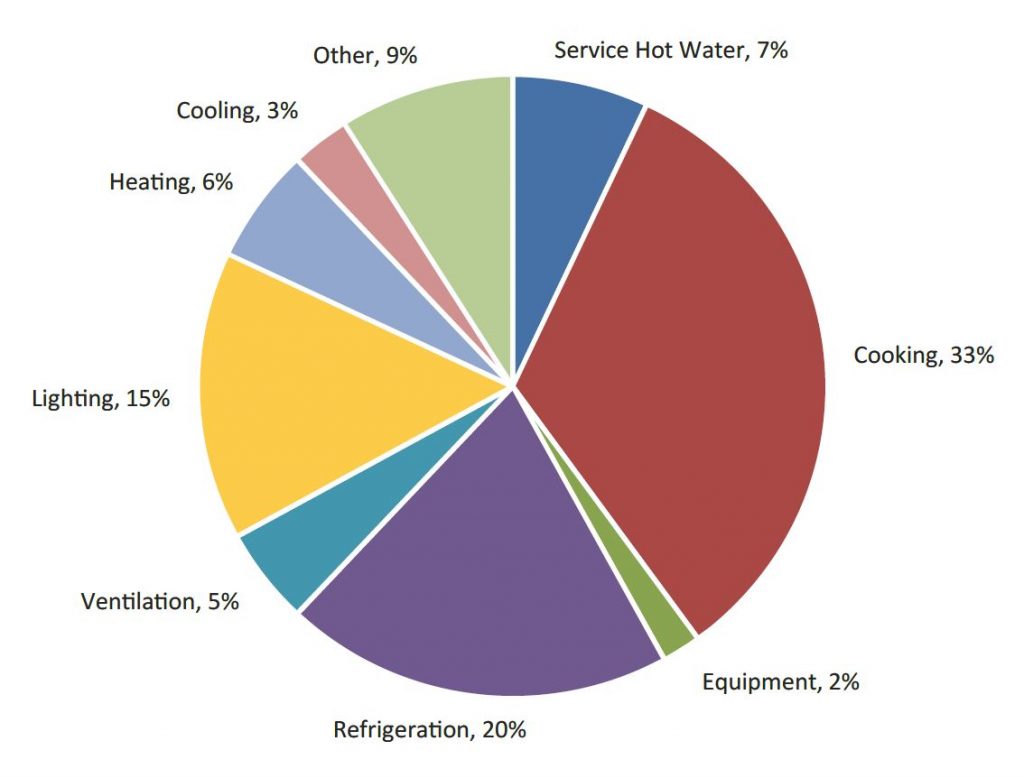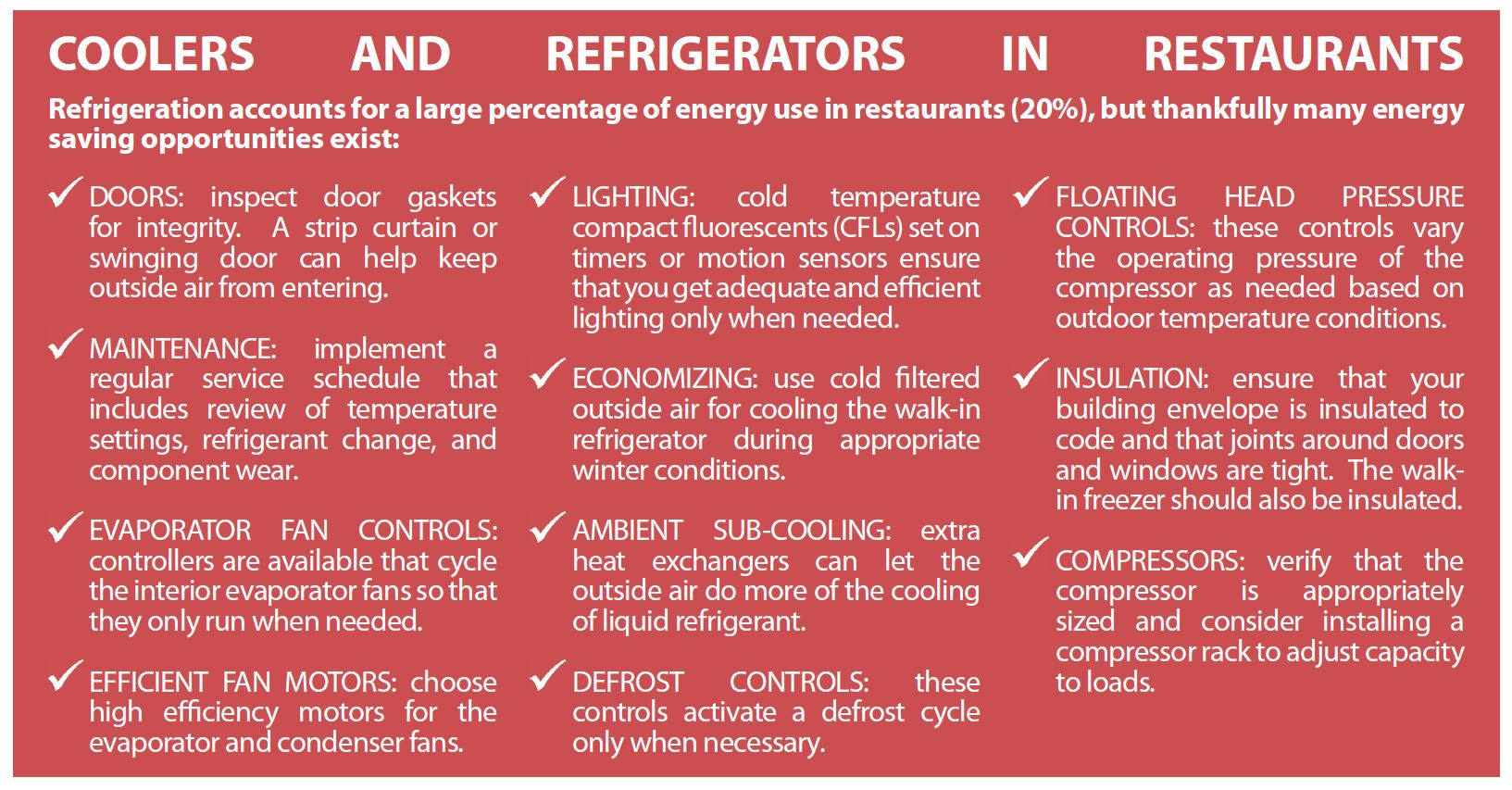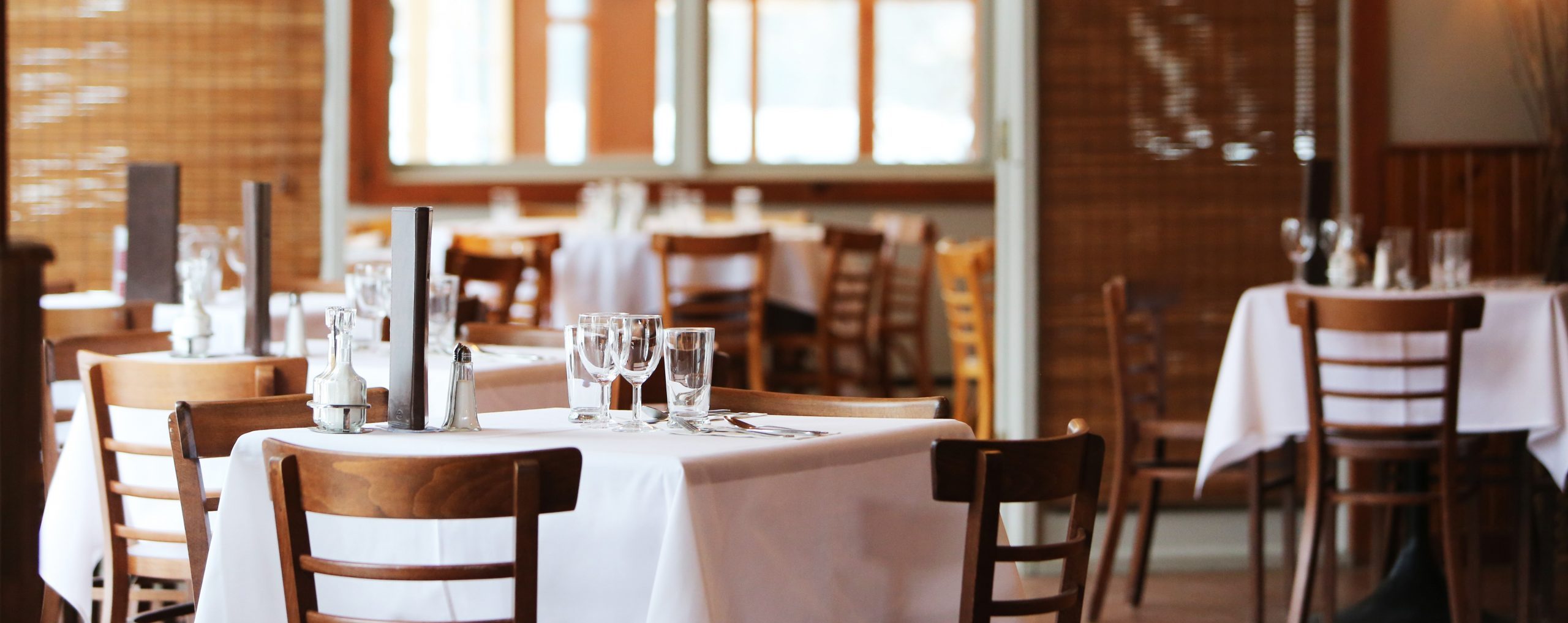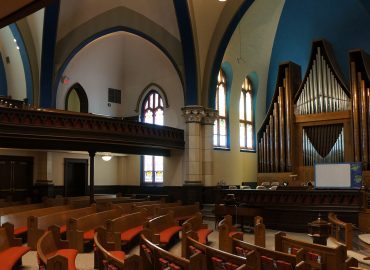Restaurants
In the United States, restaurants spend an average of $3.77 per square foot on electricity and $1.57 per square foot on natural gas annually. Typically, 3-5% of a restaurant’s total operating costs are spent on energy. Slight changes in energy use can result in a large increase in profits. Reducing energy costs by 20% is an achievable goal and contributes to the business’ profit without compromising service, quality, style, or comfort.
Cooking, refrigeration, and lighting are prime targets for energy savings. Together, these areas represent approximately 68% of total energy costs. Many energy efficiency measures can be implemented with little to no financial investment. In fact, smart use of kitchen equipment alone can save an estimated 7% of energy consumption.
Simple behavior changes such as turning off sections of griddles and broilers during slow periods or eliminating long oven preheat times can save hundreds of dollars every year. Other energy improvements require an initial financial investment but will yield savings that can pay for themselves and will reduce maintenance costs, increase comfort, and improve the appearance of your restaurant.
This fact sheet explains the steps to take and the systems to implement so that you may provide a comfortable and energy efficient environment for your patrons and employees.
In the United States, restaurants spend an average of $3.77 per square foot on electricity and $1.57 per square foot on natural gas annually. Typically, 3-5% of a restaurant’s total operating costs are spent on energy. Slight changes in energy use can result in a large increase in profits. Reducing energy costs by 20% is an achievable goal and contributes to the business’ profit without compromising service, quality, style, or comfort.
Cooking, refrigeration, and lighting are prime targets for energy savings. Together, these areas represent approximately 68% of total energy costs. Many energy efficiency measures can be implemented with little to no financial investment. In fact, smart use of kitchen equipment alone can save an estimated 7% of energy consumption.
Many energy efficiency measures can be implemented with little to no financial investment. In fact, smart use of kitchen equipment alone can save an estimated 7% of energy consumption. Simple behavior changes such as turning off sections
of griddles and broilers during slow periods or eliminating long oven preheat times can save hundreds of dollars every year. Other energy improvements require an initial financial investment but will yield savings that can pay for themselves and will reduce maintenance costs, increase comfort, and improve the appearance of your restaurant.
Regardless of whether you rent or own your building, there are a number of energy saving measures that can be implemented in the short term, as well as many longer-term measures that can be outstanding investments for your business. By investing in the efficient use of energy in your restaurant, you will reduce your operating costs, buffer your business from future energy cost increases, lower your environmental impact, and increase your long-term profitability. Conservation measures also enhance the aesthetics of your restaurant, improve comfort, improve the health of your staff, and reduce maintenance costs.
At SEDAC, we are committed to helping you find the best energy options for your restaurant. This post explains the steps to take and the systems to implement so that you may provide a comfortable and energy efficient environment for your patrons and employees.
ENERGY USE
 For Illinois restaurants, cooking, refrigeration, and lighting are the three main categories for energy savings. This utility cost breakdown was generated using the most recent data from analyses performed by SEDAC for commercial kitchens and food service establishments throughout the state of Illinois.
For Illinois restaurants, cooking, refrigeration, and lighting are the three main categories for energy savings. This utility cost breakdown was generated using the most recent data from analyses performed by SEDAC for commercial kitchens and food service establishments throughout the state of Illinois.
QUICK TIPS
In addition to adjustments made in energy consumption for cooking, refrigeration, and lighting, these following quick tips will help your business save energy and money, and thereby increase your restaurant’s profits:
-
- Use ceiling fans year-round. In the summer, the extra circulation will allow you to set the thermostat a little warmer to save on cooling costs. In the winter, the fans will move the warm air that floats up to the ceiling back down to the floor to warm occupants.
- Install an energy management system or programmable thermostat to reduce space temperatures during unoccupied periods. A 1°F change in a thermostat setting for eight hours per day results in a 1% reduction in annual energy consumption.
- Conduct regular preventive HVAC (Heating, Ventilation, Air Conditioning) maintenance to save energy and avoid costly repairs:
1.) change air filters regularly to avoid grease and dust build-up that may restrict air flows, 2.) check the economizer to make sure it does not stay stuck open or shut, 3.) clean condenser coils to remove debris that may restrict airflow and tune up your furnace for optimal performance and ensure safe operation of the unit.

REDUCE YOUR LIGHTING LOAD WITHOUT LOSING LUMENS
Lighting is another large consumer of energy in restaurants. If your restaurant has enough natural light entering the dining area through windows, you can cut energy use and costs by installing dimming controls. These dimmers can be manually adjusted or controlled by a daylight dimming system that automatically lowers the level of light to an appropriate brightness depending on the amount of natural daylight available. Replace outdated florescent and metal halide bulbs with LEDs.
Exit signs also offer great opportunities to save energy and money. Replace any incandescent-based signs with LED exit signs (light-emitting diodes) to enjoy a return of up to 80% over its counterpart. Given their low cost and ease of insulation LED exit signs easily pay for themselves within a year in energy cost savings.
If you own the restaurant’s parking lot, you can benefit from large savings by replacing old HID lamps with LEDs. Consider reducing exterior lighting power as well; SEDAC has found that 1000-Watt metal halide parking lights can be replaced with 400-Watt metal halides and still maintain acceptable lighting levels. Also consider photosensing or time based controls to make sure lights are not accidentally left on during the day.
Another way to cut costs involves the installation of occupancy sensors in the restaurant’s restrooms and storage areas. These easy additions will switch lights off when the space is unoccupied and lights are not necessary. Specifically designed low-temperature occupancy sensors can also be installed in walk-in refrigerators. The small initial investment in occupancy sensors will pay for itself in a very short time.
Finally, the easiest solution is to turn off lights that are not being used. This step offers instant savings with no upfront cost. Simple energy management procedures and closing time checklists for turning off unused lamps can make a big difference.
ENERGY SMART SAVINGS FOR KITCHENS
Inefficiently designed and operated commercial kitchens can quickly consume a restaurant’s profits. These costs can be countered with energy efficient equipment and simple changes to use patterns. SEDAC suggests the following conservation measures:
RECLAIM WASTED HEAT
A large portion of hot water requirements may be met through the recovery of heat rejected by the condenser of a walk-in cooler’s refrigeration system. There are
two ways to harness this energy:
- Install a desuperheater heat recovery on the compressor hot gas discharge and pipe the heated water to the existing water heater.
- Re-direct hot refrigerant gas from the compressor to a specialized hot water storage tank with an integral heat exchanger.
Either option can result in savings by using energy that is otherwise lost and wasted.
EFFICIENT EXHAUSTS
A kitchen exhaust hood is typically controlled by a manual switch. Energy is wasted when the hood is switched on and left to run “full bore” whether or not food is being cooked. Kitchen hood control systems vary hood exhaust fan speed and make-up fan speed based on the amount of cooking being done. Using an infrared eye that senses the quantity of smoke and the temperature at the inlet of the hood, the controller varies the fan speed with variable frequency drive (VFD) technology. One controller can monitor up to three hoods and the associated make-up air unit.
ENERGY STAR EQUIPMENT
When new appliances are purchased, it is recommended to specify ENERGY STAR qualified products. These super-efficient models can save as much as 50 percent over their conventional counterparts. Soon, ovens and griddles will be added to the list. Visit www.energystar.gov/cfs for more information on these products and upgrade-specific cost calculators.
EDUCATE KITCHEN STAFF
Create a smart energy saving plan and get staff to participate. Develop simple energy management procedures and assign responsibility between shifts and at the end of the day for turning off cooking equipment, exhaust fans, lights, etc. Encourage everyone to fill one refrigerator/freezer to capacity before using a second one. Food wells should stay closed on prep tables, and lids should be kept on stock pots and braising pans to keep food fresh and energy bills low. Finally, maintaining a clean restaurant helps keep energy use down too. Flush broilers, keep all light fixtures and lamps free of dust and grime, clean refrigerators’ condensers and evaporator coils, and remember to defrost freezers periodically to ensure equipment is operating at maximum efficiency.
ENERGY SMART RESOURCES FOR RESTAURANTS
- ENERGY STAR Food Service Equipment Incentive Finder
Search by zip code or by product for rebates on ENERGY STAR qualified equipment.
www.energystar.gov/CFSrebate_locator - ENERGY STAR for Restaurants
This comprehensive guide includes practical tips to save more of your profits by spending less on energy.
www.energystar.gov/restaurants - The Green Restaurant Association
Since 1990, the GRA has been helping the restaurant industry on both the national and local levels to achieve environmental sustainability.
www.dinegreen.com - Food Service Technology Center
Promoting energy efficiency and performance in commercial food service since 1987.
www.fishnick.com






